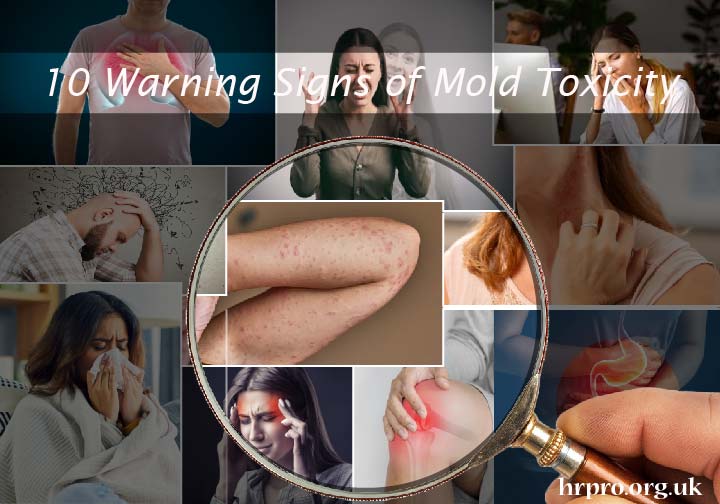Mold is a silent but dangerous threat that can creep into your home and health without you even realizing it. Mold toxicity occurs when you’re exposed to high levels of mold spores, often in your living or working environment. But how do you know if mold is affecting your health? In this article, we’ll explore the 10 warning signs of mold toxicity, helping you stay informed and take action before it’s too late.
What is Mold Toxicity?
Mold toxicity, also known as Chronic Inflammatory Response Syndrome (CIRS), occurs when your body reacts negatively to mold exposure. Mold releases tiny spores into the air, and when these spores are inhaled, they can cause a wide array of health problems, especially if you have an existing respiratory condition or weakened immune system.
Why Is Mold Dangerous?
You might think of mold as a household nuisance, but its effects can be much more severe. Long-term exposure can lead to chronic health problems, even if you’re not visibly allergic. Think of mold as a silent invader—it thrives in damp, hidden areas and slowly poisons your air without warning.
Headaches and Brain Fog
One of the most common and early signs of mold toxicity is frequent headaches or persistent brain fog. Have you ever felt mentally fuzzy for no apparent reason? That might be mold working behind the scenes. Mold toxins, known as mycotoxins, can affect cognitive function, making it hard to concentrate or think clearly.
Respiratory Issues
Mold spores, once inhaled, can wreak havoc on your respiratory system. Symptoms like coughing, wheezing, shortness of breath, or even sinus infections can be indicators of mold exposure. For those with asthma, mold can aggravate the condition, making it harder to breathe.
Skin Irritation
Mold exposure doesn’t just affect your internal organs; it can manifest on your skin as well. If you’re noticing unexplained rashes, itching, or hives, mold might be the culprit. Mold spores can irritate your skin, leading to conditions like eczema or dermatitis.
Fatigue and Weakness
Feeling constantly drained, even after a good night’s sleep? Mold exposure could be responsible for that unexplained fatigue and weakness. The toxins from mold can trigger an immune response, causing your body to work overtime, leaving you feeling exhausted.
Digestive Problems
Believe it or not, mold toxicity can also affect your gut. Symptoms such as nausea, diarrhea, and abdominal cramping may indicate that your body is reacting to mold exposure. Since mold toxins can affect various systems in the body, they can disrupt your digestive health too.
Allergic Reactions
If you find yourself sneezing, coughing, or dealing with watery eyes frequently, mold could be to blame. These symptoms are similar to seasonal allergies, but if they persist all year long or worsen in certain environments, it’s worth considering mold as a source.
Mood Swings and Anxiety
Mold doesn’t just affect your body—it can also mess with your mind. Many people exposed to mold report experiencing mood swings, irritability, or anxiety. These mental health symptoms can develop when mold toxins interfere with the body’s neurochemical balance.
Joint and Muscle Pain
Joint pain, muscle aches, or cramps that have no clear origin might also be linked to mold toxicity. The inflammatory response caused by mold can trigger pain and stiffness, especially in those who already suffer from chronic pain conditions.
Frequent Infections
If you’re suddenly getting more infections than usual, such as sinus infections or respiratory infections, mold exposure could be weakening your immune system. Mold spores can act like allergens or irritants, and over time, this constant battle can wear down your body’s defenses.
How to Protect Yourself
So, what can you do if you suspect mold toxicity? The first step is identifying and removing the source of mold in your home. If you can’t see the mold but suspect its presence, it’s wise to hire a professional mold inspector. Keep your living space dry and well-ventilated to avoid future mold growth.
If you’re dealing with symptoms mold toxicity of warning signs, see a healthcare provider. Treatments vary, but they often include reducing mold exposure, detoxifying the body, and supporting the immune system with supplements and a healthy diet.
Conclusion
Mold toxicity is often overlooked, but it can have serious health consequences. The key to protecting yourself is being aware of the symptoms and taking action if you suspect mold in your home. By recognizing the warning signs of Mold Toxicity—like headaches, respiratory issues, skin irritation, and fatigue—you can prevent long-term damage to your health.
FAQs
1. Can mold exposure cause long-term health problems?
Yes, prolonged mold exposure can lead to chronic conditions, including respiratory issues, cognitive decline, and immune system dysfunction.
2. How do I know if mold is causing my symptoms?
If you experience symptoms that worsen in certain environments or persist despite treatment, mold could be the hidden cause. A professional inspection can confirm this.
3. Can mold grow in any home?
Yes, mold can grow in any home if the conditions are right. It thrives in damp, dark environments such as basements, bathrooms, and under sinks.
4. How can I prevent mold growth in my home?
Keeping your home dry and ventilated is key. Fix leaks promptly, use dehumidifiers, and ensure proper ventilation in damp areas.
5. Is there a test for mold toxicity?
Yes, some healthcare providers offer blood tests or urine tests to detect mold exposure. However, it’s essential to also address the environmental cause by removing mold from your home.






